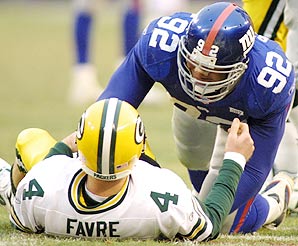by Chase Stuart
on February 1, 2014
Tonight, the newest members of the Class of 2014 will be announced. Here are the 15 finalists:
[continue reading…]
Tagged as:
Aeneas Williams,
Andre Reed,
Charles Haley,
Claude Humphrey,
Derrick Brooks,
Eddie DeBartolo,
Jerome Bettis,
John Lynch,
Kevin Greene,
Marvin Harrison,
Michael Strahan,
Morten Andersen,
Ray Guy,
Tim Brown,
Tony Dungy,
Walter Jones,
Will Shields
{ }
by Chase Stuart
on July 11, 2012
Thirty years ago, the NFL began officially recording defensive player sacks. Prior to 1982, all teams kept their own individual sack data, but those records (with few exceptions) have never been verified. As a result, it’s an unfortunate reality that for much of NFL history, we simply do not have reliable sack data for individual defensive players.
Three times, Deacon Jones produced 20+ unofficial sacks in the 1960s. In 1967, Raiders defensive end Ben Davidson Ike Lassiter had 17 sacks in the AFL. Jack Youngblood and Jim Katcavage both led the league in sacks on two different occasions in the pre-1982 era. Cincinnati Bengal Coy Bacon has been credited with 21.5 unofficial sacks during in 1976. The first team to record 60 sacks in a season was the ’57 Bears, and we can be sure that Doug Atkins recorded more than his fair share of that number. For players like Gino Marchetti, Norm Willey, and Len Ford, even unofficial records weren’t kept during their time, leaving us unsure as to who is the true sack king.
It’s important to remember that just because we don’t have official sack data before 1982 doesn’t mean there were great sack artists before then. But that’s a topic for another today. So while we can’t precisely measure how the forefathers of the game played, we do have official data for the last 30 years. So who has been the best pass rusher of the last three decades?

Brett, are you SURE you're okay?
Using total sacks isn’t a fair method to current players, or to those players who chose to retire instead of sticking around to compile six-sack seasons. So if we want to measure sack dominance, we can’t simply look at total sacks any more than we can grade running backs by looking at career rushing yards. One method I like that I’ve used before is sacks over one-half sack per game. This makes 8 sacks in a 16-game season the bar; a player only gets credit for their production over that level. This means that 12 sacks in a 16-game season brings a value of +4.00, while 16 sacks is twice as valuable at +8.00.There’s no great reason to choose 8 over 6 or 10 or any other number. I chose 8 because it feels right, but I don’t claim that it’s based on anything other than my personal, subjective preference.
[continue reading…]
Tagged as:
Bruce Smith,
DeMarcus Ware,
Jared Allen,
Lawrence Taylor,
Michael Strahan,
Reggie White,
Sacks,
Simeon Rice
{ }

